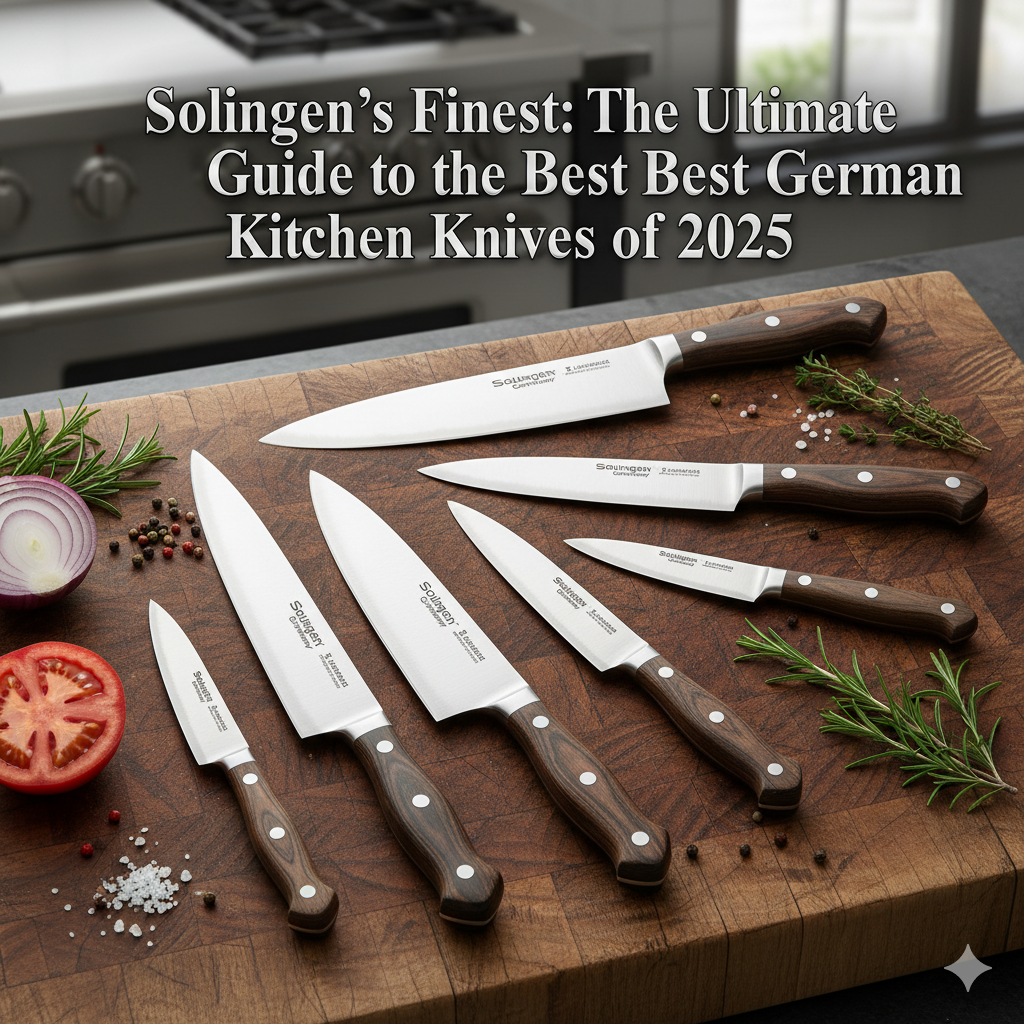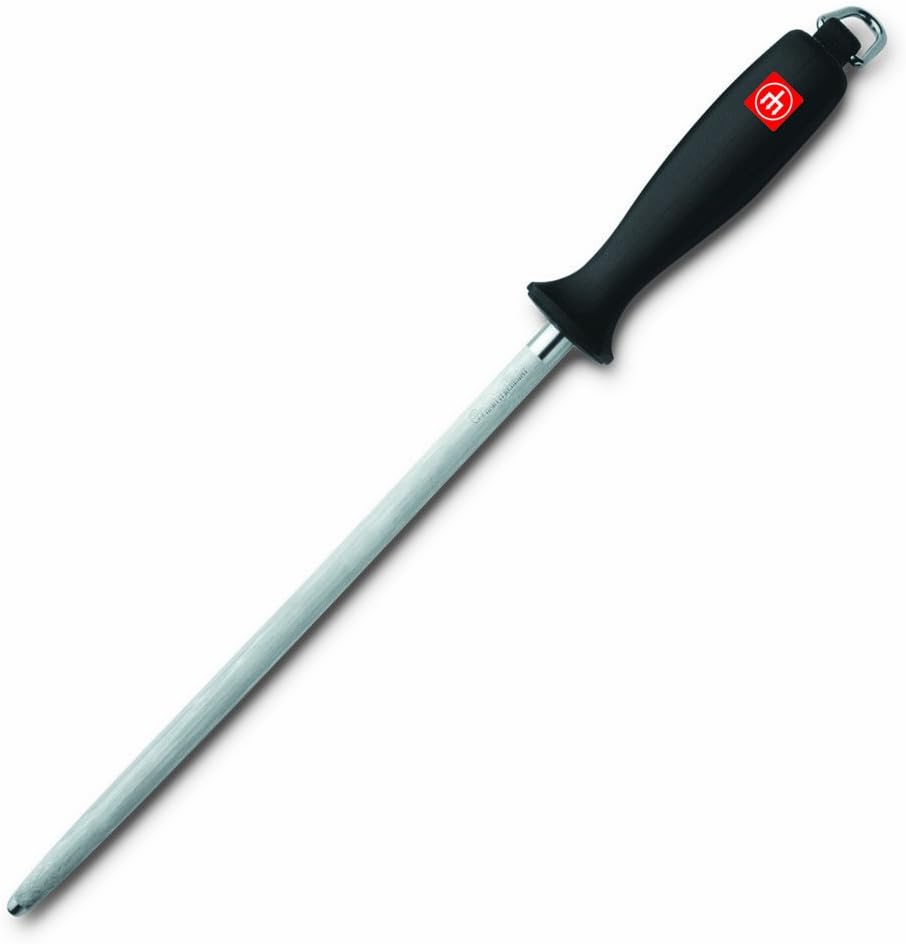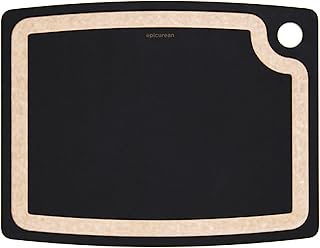Solingen’s Finest: The Ultimate Guide to the Best German Kitchen Knives of 2025
In the world of culinary tools, few terms command as much respect as “German steel.” It evokes images of uncompromising quality, centuries of craftsmanship, and a blade that is not just sharp, but virtually indestructible. A German kitchen knife is more than a cutting tool; it’s a lifetime investment in performance. It’s the dependable, powerful, and perfectly balanced workhorse that forms the backbone of professional and home kitchens across the globe. Today, we’re diving deep into the heart of Solingen, the legendary “City of Blades,” to find the absolute best knives Germany has to offer.

The Indestructible Intern: A Lesson in German Resilience
My first real restaurant job was in a high-volume French bistro. The kitchen was a chaotic ballet of blistering heat and intense pressure. On my first day, the executive chef handed me a beat-up, worn-down chef’s knife. The handle was scarred, the logo was faded, but it felt impossibly solid in my hand. “This is your knife,” he said. “It was my first knife. Don’t break it.” That knife was a Wüsthof Classic, and over the next year, I put it through absolute hell. It chopped through countless cases of onions, broke down whole chickens, and was occasionally used (I’m not proud of this) to pry open stubborn cans. It was dropped, abused, and sharpened aggressively on the house’s electric sharpener.
Through it all, it never chipped, bent, or failed me. It just kept taking an edge and asking for more. Meanwhile, I saw other cooks with fancier, more delicate knives that would chip or break under the intense pressure. That Wüsthof taught me the core truth of German cutlery: it is built to endure. It’s not just about sharpness; it’s about resilience. This guide is a tribute to that indestructible spirit—a search for the knives that will be the reliable heart of your kitchen for decades to come.
Forged in Fire: How We Define a Superior German Knife
The “Made in Germany” label, especially from Solingen, carries immense weight. To honor that tradition, we established a rigorous set of criteria to evaluate these culinary titans. We looked beyond the brand name to the specific attributes that make German knives the workhorses of the world.
Our Core Philosophy: A great German knife is a perfect synthesis of three elements: a tough, durable blade that holds a practical edge; a comfortable, secure handle that offers total control; and a robust, balanced construction (full tang and bolster) that makes the knife feel like a natural extension of your hand.
- Steel Quality (The Solingen Standard): The soul of the knife. We focused on knives forged from high-carbon stainless steel, specifically the German standard X50CrMoV15. This steel provides an excellent combination of toughness (resistance to chipping), stain resistance, and the ability to be easily honed and sharpened.
- Construction (Forged, Full Tang, Full Bolster): We prioritized traditionally forged knives. A forged knife is made from a single piece of steel, giving it superior strength. We looked for a **full tang** (the steel extends to the end of the handle) for perfect balance and a **full bolster** (the thick piece of metal between the blade and handle) which acts as a finger guard and adds to the balance.
- Edge Geometry & Sharpness: German knives are typically sharpened to a 20-degree angle per side. This is a robust, durable edge that may not feel as razor-thin as a Japanese blade but holds up far better to vigorous chopping and heavy use. We tested for a keen, durable edge that could be easily maintained.
- Handle Ergonomics & Material: The handle is your interface with the blade. We looked for comfortable, triple-riveted handles made from high-impact, durable synthetic materials like Polyoxymethylene (POM), which resists fading and discoloration.
- Brand Heritage & Craftsmanship: We focused on the titans of Solingen—brands with centuries of experience. The fit and finish, the seamless transition from bolster to handle, and the overall feeling of quality were all heavily considered. This is where the great debate between the top brands, detailed in articles like Wüsthof vs. Zwilling vs. Shun, truly comes to life.
The Honor Roll: The Best German Knives of 2025
If you’re ready to invest in a lifetime of quality cutting, these are the best German knives you can buy.
| Knife | Image | Brand | Best For | Check on Amazon |
|---|---|---|---|---|
| Wüsthof Classic 8″ Chef’s Knife |  |
Wüsthof | The Indestructible Workhorse | View Price |
| Zwilling Pro 8″ Chef’s Knife |  |
Zwilling J.A. Henckels | Ergonomics & Modern Design | View Price |
| Messermeister Meridian Elité 9″ Chef’s Knife |  |
Messermeister | Best for a Lighter Touch | View Price |
| Wüsthof Classic 7″ Santoku |  |
Wüsthof | Best for Vegetables | View Price |
| Henckels International Classic 8″ Chef’s Knife |  |
Henckels | Best Value Forged Option | View Price |
The Titans of Solingen: In-Depth Reviews of the Best German Knives
We chopped, diced, and carved our way through a mountain of ingredients to put these legendary blades to the ultimate test. Here’s how they performed.
1. Wüsthof Classic 8-Inch Chef’s Knife (The Indestructible Workhorse)
This is arguably the most recognizable and respected chef’s knife on the planet. The Wüsthof Classic is the definition of a German workhorse. Forged from a single piece of high-carbon stainless steel, it features a full bolster and a full tang, giving it a feeling of perfect balance and immense strength. The 8-inch blade has a classic profile that excels at rock-chopping, and its 58 Rockwell hardness makes the steel tough enough to absorb punishment but soft enough to be easily sharpened to a screaming edge.
This knife feels powerful and precise. It gives you the confidence to tackle any task in the kitchen. It’s the standard against which all other workhorse knives are measured, a fact highlighted in our detailed Wüsthof vs. Victorinox comparison. If you could only own one knife for the rest of your life, this would be a top contender.
Who is this best for?
Anyone, from a professional chef to a serious home cook, who wants the undisputed benchmark for a durable, all-purpose, high-performance chef’s knife.
- Legendary durability and resilience
- Perfectly balanced with a full tang and bolster
- Made in Solingen, Germany, for over 200 years
- Extremely comfortable and secure handle
- Easy to hone and sharpen
Pros
- Heavier than Japanese-style knives
- Premium price point
Cons
2. Zwilling Pro 8-Inch Chef’s Knife (Ergonomics & Modern Design)
Zwilling J.A. Henckels brings a touch of modern innovation to the classic German knife. The Zwilling Pro is also forged in Solingen from a proprietary steel formula and is ice-hardened (FRIODUR) for enhanced sharpness and corrosion resistance. Its most distinctive feature is the curved bolster, designed by architect Matteo Thun. This curve encourages a proper “pinch grip,” making the knife exceptionally comfortable and an extension of your hand. The blade also has a slightly broader curve than the Wüsthof, making it a rock-chopping machine.
This knife feels a bit more refined and “designed” than the classic Wüsthof, and many chefs prefer its unique ergonomics. It represents the pinnacle of Zwilling’s engineering, a topic we dive into in our Zwilling vs. Henckels guide, which clarifies the difference between the company’s brands. For a modern take on German perfection, the Zwilling Pro is a masterpiece.
Who is this best for?
The cook who values modern ergonomics and a refined feel, and those who use a pinch grip and will benefit from the innovative curved bolster.
- Unique curved bolster for superior comfort and control
- Ice-hardened blade for excellent edge retention
- Slightly more curved blade is great for rock-chopping
- Impeccable German fit and finish
Pros
- Curved bolster can be tricky with some sharpeners
- Also a premium price point
Cons
3. Messermeister Meridian Elité 9-Inch Chef’s Knife (Best for a Lighter Touch)
Messermeister, “the knife master,” is the hidden gem of Solingen. This boutique, woman-owned company creates knives with a slightly different philosophy. The Meridian Elité line is also forged from the same German steel, but it’s known for having a thinner blade profile, closer to a Japanese knife. It also features a quarter-bolster instead of a full bolster, which makes the knife lighter and allows for sharpening the entire length of the blade. This results in a German knife with the soul of a workhorse but the agility of a more nimble blade.
This 9-inch version offers extra length for tackling larger projects without feeling unwieldy. It’s for the cook who finds other German knives a bit too heavy but still wants that German durability. Messermeister offers a fantastic alternative to the big two and is a favorite among professional chefs. After using it, you might just find your new favorite among the best chef knife brands.
Who is this best for?
The chef who wants German durability but prefers a lighter, more agile knife with a thinner blade. An excellent “hybrid” choice.
- Lighter and more nimble than other German knives
- Quarter-bolster allows for full-length sharpening
- Hand-finished for an exceptionally sharp edge out of the box
- Classic, comfortable handle design
Pros
- Less brand recognition than Wüsthof or Zwilling
- Thinner blade is slightly less robust for heavy-duty tasks
Cons
4. Wüsthof Classic 7-Inch Santoku (Best for Vegetables)
While the chef’s knife is the king of versatility, the Santoku is the master of vegetables. This Wüsthof Classic Santoku brings German engineering to the Japanese-style blade. It has a flatter belly, a sheepsfoot tip, and a shorter 7-inch length, making it ideal for quick, downward chops rather than rock-chopping. The hollow-ground indentations (kullenschliff) create air pockets to reduce friction and prevent food from sticking—a massive help when dicing potatoes or cucumbers.
It has all the hallmarks of the Wüsthof Classic line: forged, full tang, and incredibly durable. It’s the perfect companion to a German chef’s knife, giving you a specialized tool for veggie-heavy prep. The German vs. Japanese knife debate is fascinating, especially when one style is made by the other, as we explore in our Shun vs. Wüsthof article. This is German steel perfected for a Japanese task.
Who is this best for?
The home cook who does a lot of vegetable prep and wants a specialized blade that excels at dicing, mincing, and slicing, with the durability of German steel.
- Excels at vegetable prep with its flat edge
- Hollow-ground edge reduces food sticking
- Shorter blade is very nimble and easy to control
- Features the same legendary Classic build quality
Pros
- Less versatile than a traditional chef’s knife
- Not ideal for rock-chopping motion
Cons
5. Henckels International Classic 8-Inch Chef’s Knife (Best Value Forged Option)
Want the feel and durability of a forged German knife without the steep price tag of a Wüsthof or a premium Zwilling? The Henckels International Classic line is the answer. These knives are made in Spain, but they are designed by Zwilling and forged from high-quality German steel. This 8-inch chef’s knife features a full bolster and a full tang, giving it the authentic weight and balance you expect from a German knife.
While the fit and finish may not be quite as refined as its more expensive cousins, the performance is exceptional for the price. It’s a true forged knife that offers incredible durability and value. It’s a fantastic entry point into the world of German cutlery and a perfect choice for those looking for the best budget chef knife that is still forged. Our Henckels vs. Victorinox comparison shows just how well this value-forged knife stacks up against the king of stamped blades.
Who is this best for?
The home cook on a budget who wants the balance, durability, and feel of a true forged German knife at an unbeatable price point.
- True forged construction at an incredible price
- Features a full bolster and full tang for great balance
- Made with high-quality German stainless steel
- Excellent entry into the world of German knives
Pros
- Made in Spain, not Solingen
- Edge may require more frequent honing
Cons
Your German Knife Questions, Answered
What makes German knives from Solingen so special?
Solingen, Germany, has been a center for blade-making for centuries and has a protected designation of origin (like Champagne in France). Knives from Solingen are globally recognized for their incredibly high standards of manufacturing. They are typically forged from a single piece of high-carbon stainless steel, feature robust construction like a full tang and bolster for perfect balance, and use a steel formula (X50CrMoV15) that is prized for being extremely tough, chip-resistant, and easy to sharpen. They are the definition of a kitchen workhorse.
What is the difference between Wüsthof and Zwilling J.A. Henckels?
They are the two titans of Solingen and their rivalry is legendary. While both produce knives of exceptional quality, there are subtle differences. Wüsthof generally uses a slightly softer steel (58 HRC) which many chefs find easier to sharpen and incredibly tough. Zwilling often uses a slightly harder, proprietary ice-hardened steel (FRIODUR, typically 57 HRC) which can offer slightly better edge retention. Aesthetically, Wüsthof’s premier “Classic” line has a more traditional, angular design, while Zwilling’s “Pro” line features a modern, curved bolster for a different feel. It often boils down to personal preference in balance and ergonomics.
Are German knives better than Japanese knives?
Neither is better, they are just different tools for different philosophies. Think of it like a durable pickup truck versus a high-performance racecar. A German knife is the pickup truck: robust, powerful, incredibly durable, and can handle any job you throw at it. A Japanese knife is the racecar: lighter, harder, thinner, and capable of surgical precision, but also more delicate. For all-around, heavy-duty kitchen work, German knives are unparalleled. For delicate, precise slicing, Japanese knives excel.
How do I care for my German knife?
Caring for a German knife is simple. First, always hand wash it with warm, soapy water and dry it immediately; never put it in the dishwasher, even if you own a set of dishwasher safe steak knives, as the harsh environment is bad for a fine-edged chef’s knife. Second, store it properly in a block, on a magnetic strip, or in a drawer organizer—never loose in a drawer. Finally, hone it regularly with a honing steel (once a week is great) to maintain the edge, and have it sharpened once or twice a year when honing no longer brings back the sharpness.
The Final Verdict: Investing in a Legacy of Quality
A German kitchen knife is more than just a purchase; it’s an adoption. It’s a tool that, with a little care, will become a trusted partner in your kitchen for the rest of your life. The feeling of quality, the perfect balance, and the sheer cutting power of a well-made Solingen blade is something every serious cook should experience.
For the purist who wants the undisputed, time-tested champion of the kitchen, the Wüsthof Classic 8-Inch Chef’s Knife is a flawless choice. It is the benchmark against which all others are judged.
For the cook who appreciates a more modern, ergonomic feel without sacrificing an ounce of German power, the Zwilling Pro 8-Inch Chef’s Knife is an innovative masterpiece. And for those who want that legendary forged quality at a more accessible price, the Henckels International Classic offers unbeatable value.
Choose any knife from this list, and you are not just buying a piece of steel. You are investing in centuries of tradition, precision engineering, and a legacy of culinary excellence that you will feel with every single cut.
























